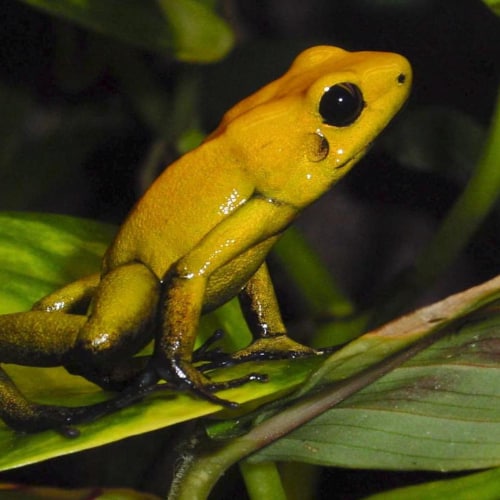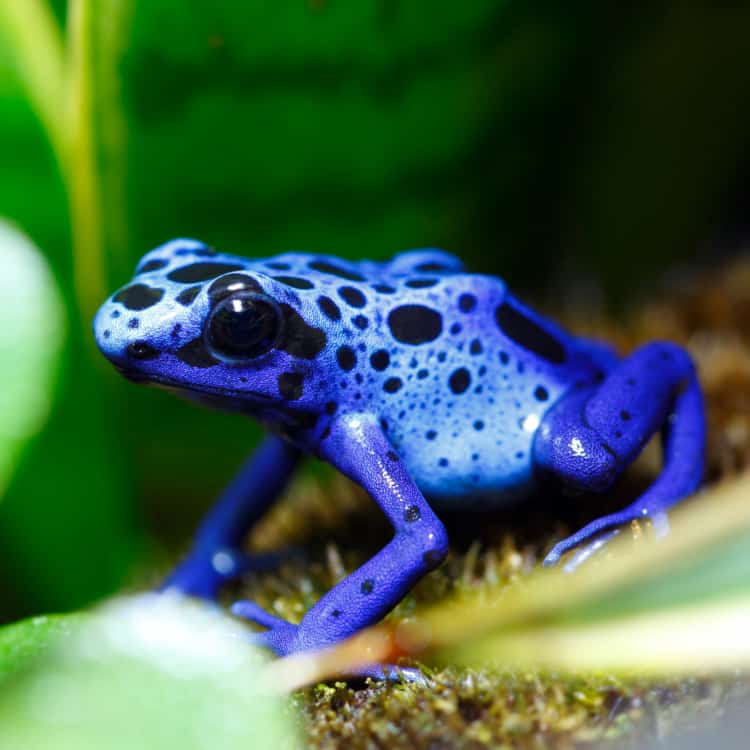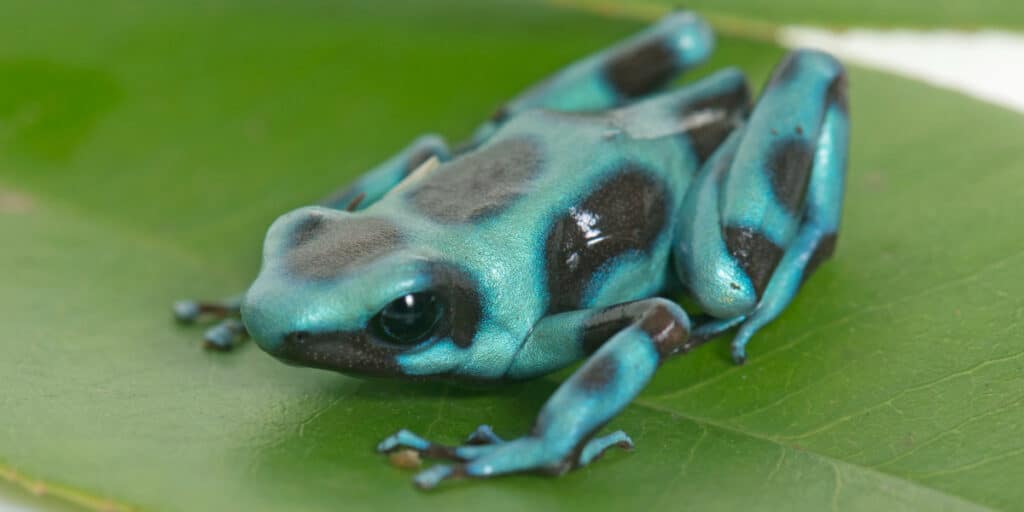You want a Dart Frog as a pet, but is it really poisonous?!
OK, I get it, you really want a dart frog as a pet. Why wouldn’t you? They’re stunning little creatures. But the question a lot of people ask, is a dart frog really poisonous?
Well yes, in fact, they are actually very poisonous. Poison dart frogs are one of the most poisonous animals on earth.
These bright coloured amphibians are native to Central and South America, but can be found in pet stores around the world. They have a very toxic skin coating that they use for protection from predators.

The Phyllobates terribilis (Golden Poison Frog), native to Colombia, is considered to be the most poisonous frog, if not animal, on earth. One frog on average could kill 10 humans and is also likely to kill you in as many minutes. Hardly surprising then that they are used to poison hunting darts.
Well, the good news is, while they are highly toxic in the wild, dart frogs in captivity are not at all poisonous. It is not fully understood what makes them poisonous in the wild, but it is thought to be their diet.
Why Dart Frogs Make Great Pets
If you are looking for a colourful, exotic and low-maintenance pet, you might want to consider dart frogs. These tiny amphibians are native to the tropical rainforests of Central and South America, where they live on the forest floor and feed on insects. Despite their name, dart frogs are not poisonous in captivity, as they lose their toxicity when they are fed a different diet than in the wild. In fact, dart frogs are very harmless and docile, and can be safely handled with bare hands.
Dart frogs are easy to care for, as long as you provide them with a suitable habitat and a varied diet. They need a humid and warm terrarium, with a substrate of coco fibre, sphagnum moss or leaf litter, and plenty of plants and hiding places. They also need a shallow water dish for drinking and soaking. You can keep several dart frogs in the same terrarium, as they are social and enjoy each other’s company. However, you should avoid mixing different species or morphs, as they might hybridise or fight.
Here are some tips on how to set up a cosy and stimulating environment for your new friends
First, you’ll need a terrarium that is large enough to accommodate the number and size of your frogs. A general rule of thumb is to have at least 10 gallons of space per frog, but more is always better. You’ll also want to choose a terrarium that has a secure lid, good ventilation, and easy access for cleaning and feeding.
Next, you’ll need to create a substrate layer that mimics the natural soil of the rainforest where dart frogs live. You can use a mix of coco fibre, sphagnum moss, orchid bark, and leaf litter to create a moist and organic base for your terrarium. You’ll also need to add a drainage layer of gravel or clay balls at the bottom of the terrarium to prevent waterlogging and mould growth.
Then, you’ll need to add some plants and decorations that will make your frogs feel at home. You can use live or artificial plants, but make sure they are safe and non-toxic for your frogs. Some good choices are bromeliads, ferns, orchids, mosses, and vines. You can also add some rocks, driftwood, cork bark, or coconut shells to create hiding places and climbing surfaces for your frogs.
Finally, you’ll need to maintain the proper temperature and humidity for your frogs. Dart frogs prefer a temperature range of 70-80°F and a humidity level of 80-100%. You can use a thermometer and a hygrometer to monitor these conditions in your terrarium. You may also need to use a heat lamp or a heat mat to provide some warmth, and a misting system or a spray bottle to keep the substrate moist.
By following these steps, you’ll be able to create a beautiful and comfortable habitat for your pet dart frogs. They will reward you with their bright colours, cheerful chirps, and curious personalities.

Dart frogs are active during the day, and will delight you with their bright colours and lively behaviour. They have a wide range of patterns and hues, from blue to yellow to red to green. Some of the most popular species are the blue poison dart frog (Dendrobates tinctorius azureus), the strawberry poison dart frog (Oophaga pumilio), and the golden poison dart frog (Phyllobates terribilis). Each species has its own personality and preferences, so you should do some research before choosing your dart frog.
What do dart frogs eat
Dart frogs are omnivorous animals that feed on small insects in the wild. They prefer insects with soft exoskeletons, such as ants, flies, and mites. Some of the insects they eat may contribute to their toxicity, as they contain alkaloids that the frogs store in their skin glands. In captivity, dart frogs can eat a variety of live insects that are gut-loaded and dusted with supplements. Some of the insects that are suitable for dart frogs are:
- Fruit flies: These are easy to culture and are a staple food for dart frogs. There are two types of fruit flies commonly used: melanogaster and hydei. Melanogaster are smaller and suitable for young froglets and larger dart frogs. Hydei are slightly larger and contain more protein. Both types are wingless and enriched with calcium, magnesium, and iron.
- Springtails: These are small arthropods that can be cultured with charcoal and rice. They are perfect for dart frogs’ snacks and can help clean the vivarium. However, they lack some vital nutrients, so they should not be the main food source for dart frogs.
- Isopods: These are also known as pill bugs or woodlice. They are crustaceans that can be cultured with wood, leaves, and soil. They are high in calcium and can help break down organic matter in the vivarium. They can be fed to larger dart frogs, but they may hide under the substrate or plants.
- Bean beetles: These are beetles that feed on beans and can be cultured in a container with dry beans. They are high in protein and fat, but low in calcium. They can be fed to larger dart frogs as an occasional treat, but they should not be overfed or used as a staple food.
- Rice flour beetles: These are beetles that feed on rice flour and can be cultured in a container with rice flour and yeast. They are small and suitable for young froglets and smaller dart frogs. They are high in protein, but low in calcium and moisture. They should be supplemented with calcium and vitamin D3 before feeding to dart frogs.
- Phoenix worms: These are larvae of the black soldier fly and can be purchased online or from pet stores. They are high in calcium, protein, and fat, but low in moisture. They can be fed to larger dart frogs as an occasional treat, but they should not be overfed or used as a staple food.
- Pinhead crickets: These are baby crickets that can be purchased online or from pet stores. They are high in protein, but low in calcium and moisture. They should be gut-loaded with nutritious food and dusted with supplements before feeding to dart frogs. They can be fed to larger dart frogs as a staple food, but they should not be fed to young froglets or smaller dart frogs.
- Mealworms: These are larvae of the darkling beetle and can be purchased online or from pet stores. They are high in protein and fat, but low in calcium and moisture. They have a hard exoskeleton that can cause impaction in dart frogs, so they should be avoided or fed sparingly to larger dart frogs as an occasional treat.
- Repti worms: These are also known as calci worms or nutri grubs. They are larvae of the black soldier fly and can be purchased online or from pet stores. They are high in calcium, protein, and fat, but low in moisture. They can be fed to larger dart frogs as an occasional treat, but they should not be overfed or used as a staple food.
- Hydei fruit flies: These are the same as the fruit flies mentioned above, but they are a different type of fruit fly commonly used for feeding reptiles and amphibians. They are larger than melanogaster fruit flies and contain more protein. They can be fed to larger dart frogs as a staple food, but they may be too big for young froglets or smaller dart frogs.
- Calci worms: These are the same as the repti worms mentioned above, but they are a different name for the same product.
- White worms: These are small worms that can be cultured with peat moss and oatmeal. They are high in protein and fat, but low in calcium and moisture. They can be fed to larger dart frogs as an occasional treat, but they should not be overfed or used as a staple food.
Dart frogs should have access to fresh water at all times, preferably filtered or dechlorinated water. They should also have a varied diet that includes different types of insects to provide them with a balanced nutrition.
Poison dart frogs are colourful and fascinating amphibians that can be kept as pets in captivity. However, they have some special requirements and challenges that owners should be aware of. Here are some common health issues that may affect dart frogs in captivity and how to prevent or treat them:
- Nutritional deficiencies: Dart frogs need a balanced diet of live insects, such as fruit flies, springtails, pinhead crickets, and isopods, dusted with calcium and vitamin supplements. A lack of certain minerals or vitamins can cause problems such as poor growth, bone deformities, muscle weakness, or skin infections . To avoid this, owners should provide a variety of prey items and use high-quality supplements regularly.
- Mechanical wounds: Dart frogs can injure themselves by scratching, biting, or rubbing against sharp or rough objects in their enclosure. These wounds can become infected by bacteria or fungi and lead to inflammation, swelling, or tissue damage. To prevent this, owners should inspect their enclosure regularly and remove any potential hazards. They should also keep the enclosure clean and humid to promote healing and prevent dehydration.
- Red-leg syndrome: This is a serious bacterial infection that affects the skin and internal organs of dart frogs. It causes redness, ulceration, and bleeding of the legs and belly, as well as lethargy, loss of appetite, and death . The exact cause of this disease is unknown, but it may be related to stress, poor hygiene, overcrowding, or low immunity. To prevent this, owners should maintain optimal temperature and humidity levels in the enclosure, avoid overhandling or disturbing their frogs, and quarantine any new or sick frogs.
- Fungal infections: Dart frogs can contract fungal infections from contaminated water, substrate, or food. These infections can cause skin lesions, blisters, or white patches on the body . To prevent this, owners should use filtered or dechlorinated water for misting and soaking their frogs, change the substrate regularly, and disinfect the enclosure and accessories periodically.
- Spring disease: This is a viral infection that affects the nervous system of dart frogs. It causes abnormal movements, such as twitching, spinning, or rolling, as well as paralysis and death . There is no cure for this disease and it can spread quickly among frogs. To prevent this, owners should obtain their frogs from reputable sources, avoid mixing different species or populations of frogs, and isolate any affected frogs.
Keeping dart frogs healthy in captivity requires careful attention to their diet, environment, and behaviour. Owners should monitor their frogs regularly for any signs of illness or injury and seek veterinary advice if needed.
Dart frogs can live for up to 10 years or more in captivity, if they are well cared for. They are fascinating and rewarding pets, that will bring a touch of the tropics to your home. If you are interested in dart frogs, you should visit a reputable breeder or pet store, and learn more about these amazing animals.
They make great pets because their diet consists mainly of live insects which makes them easy to care for!
The pros and cons of keeping dart frogs:
If you’re still interested in having a dart frog as a pet, here are some of the pros and cons you should consider:
Pros:
- They are beautiful and colourful animals that will brighten up your home.
- They are active and curious creatures that will keep you entertained with their antics.
- They are relatively low maintenance and don’t require much space or equipment.
- They are long-lived and can live up to 15 years or more in captivity.
- They are educational and can teach you and your kids about biology, ecology and conservation.
Cons:
- They are not cuddly or interactive pets and should not be handled or touched.
- They require a humid and warm environment that needs to be monitored and maintained regularly.
- They need a varied and live diet of insects that may be hard to find or expensive.
- They may be illegal or restricted in some areas due to their endangered status or potential risk.
- They may be noisy or smelly depending on the species and their enclosure.
Conclusion
Keeping dart frogs as pets can be a rewarding and fun hobby, but it also requires a lot of care and attention. These colourful amphibians are not your typical pets, and they have some special needs that you should be aware of before you decide to bring them home.
In this blog post, I have shared some of the basics of dart frog care, such as their diet, habitat, temperature, humidity, lighting, and health. I hope you have learned something new and useful from this post, and that you are ready to take on the challenge of keeping these amazing creatures as pets.
Remember, dart frogs are not toys, and they deserve respect and love. They are also very sensitive to their environment, so make sure you provide them with the best conditions possible. If you do that, you will be rewarded with a beautiful and lively display of nature in your own home. Thank you for reading, and happy frogging!




